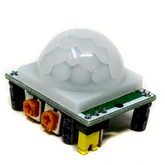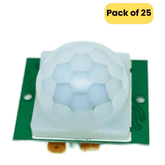PIR Sensor Applications: From Smart Homes to Industrial Automation
Summary
Discover the transformative power of PIR sensors in our latest blog, "PIR Sensor Applications." Dive into the world of smart technology with insights on home security alarm systems, energy-efficient lighting control, industrial automation protocols, and smart HVAC management. Explore how PIR sensors are revolutionizing wildlife monitoring, retail customer analytics, hands-free appliance activation, and outdoor intrusion detection. Uncover the versatility of PIR sensors across various domains, and join us on a journey through innovation. Don't miss the chance to elevate your understanding of cutting-edge sensor applications. Read more and step into the future!
Introduction
PIR (Passive Infrared) sensors becoming a cornerstone in the motion detection industry. These compact devices sense infrared light radiating from objects in their view, particularly useful for applications where human presence is to be detected. From enhancing home security systems to automating lighting and HVAC controls for energy efficiency, PIR sensor technology proves versatile across various sectors. People leverage this sensitivity to create smarter environments that react dynamically to occupancy patterns—elevating both convenience and conservation efforts as they come into broader use.

Home Security Alarm Systems
Home security alarm systems now often use PIR sensors. These detect movement by picking up changes in infrared radiation levels—basically, the heat coming from living beings like us or our pets. The core of a PIR sensor is its pyroelectric material which notices these shifts in IR.
So when people walk across their rooms, if there's a PIR sensor set up for home security, it feels that change because their body temperature differs from the surroundings. Here’s how they work: every object around emits some amount of this invisible light depending on their warmth.
Now imagine two tiny eyes (slots) covered with special stuff sensitive to IR; those are inside your standard PIR setup! They just chill there until something warmer than the background — say me or you — passes by their 'eye'. This disturbance creates what they call a positive differential change’.

These handy devices don't actually throw out any energy themselves—they're more like silent watchers gathering whispers of heat movements around them. Few people mix motion sensors and PIRs up before but remember this: all fingers are not thumbs; same way, while all PIRS sense motion somehow - not all motion detectors rely on infrared tech! For DIY enthusiasts dabbling into electronics projects involving Arduino boards – hooking a Grove-PIR Motion Sensor can be good practice since setting one isn’t too complex and resources abound online for guidance.
Learn the science behind the PIR Sensor.
Energy-Efficient Lighting Control
In the field work on energy efficiency, We have seen firsthand how smart use of PIR sensors can cut down power waste. Take the case of a large university: they set up motion detectors in their underground parking lots and dorm rooms. These aren't just any spaces; we're talking areas that see heaps of daily activity.
With these systems in place, lights only blaze when folks are around. The parking saved about 39.5 Wh per square meter each day—that’s 77% less electricity used compared to before! Dorms saw savings too over a quarter less at 28%. Imagine this tech scaled up across campuses nationwide—the impact could be huge! It's not magic—it's simply technology making sure we don’t burn through power where it'sn’t needed.
Industrial Automation Protocols
Right, let's talk industrial automation protocols and how they relate to PIR sensor applications. At the heart of any automated system is the PLC - that's a digital processor for those not in the know. It keeps an eye on inputs from sensors like our PIRs and decides what action should follow.
Now, these PLCs are tough cookies; they shrug off extreme temps, dodge electrical noise, laugh at vibrations and impacts. So when we integrate them with manufacturing lines or mechanical processes – it’s a game-changer! We tweak operations fast or copy them without breaking a sweat while raking in data by the bucketful. Think door switches stopping everything dead if someone opens up protective screens—necessary where debris flies about marking safe paths amid work zones.
Then there are lasers scanning invisibly for unwanted guests along production tracks—a big yes for places sans barriers but needing quick access. On safety again: gas detectors pair up with alarms circling back to robotics—the new frontier! We're talking adaptive robots here; reprogrammable helpers ready to shift tasks across plant floors as needed—or just get their software swapped out instead of moving muscle. And don't forget cobots—they share workspace real estate more intimately which means no sudden movements if you drop by unannounced thanks to cushioning impact layers paired with lots-o'-sensors! Just thinking about connectors brings me pride cause hey —we build ours ground-up understanding your needs firsthand: reliability rocks solid performance cornerstone stuff right there folks simple as that.
Smart HVAC Management
Smart HVAC management is all about using tech to keep us comfy while cutting down on energy use. The old way of sensing if someone was in the room helped save around 11% power before the year 2000. Now, we have better tools—thermo-fluidic sensors paired with PIR detectors—and savings jump to roughly 30%.
But it gets even cooler. When AC systems tap into data from wearables tracking our moves and body heat info, they can slash energy costs by nearly half without making us less cozy. This smart setup tunes into each person's comfort needs for just-right temps. We've made strides lately with tiny but vital thermo-fluidic sensors.
They're smarter now, with new semiconductor tech that enhances accuracy in converting physical measurements into digital signals for wireless sharing. Using this advanced gear means an AC can adjust settings based on real-time feedback tailored not just for spaces but also specific people hanging out there—which honestly feels pretty future-forward!
Wildlife Monitoring Solutions
Wildlife monitoring gets a big boost with PIR sensor. These tech bits sense heat from animals moving by, day or night. They work without harming any creature; that's key for studies on critters in the wild. We link these sensors to cameras so when something warm passes, it snaps a picture or rolls video.
With this this setup we can catch rare animal shots which can tell us lots about their ways—the times they move and places they go—without people nearby scaring them off. Scientists track numbers too; how many beasts live around? With solid data like image count over time, we see if things get better or worse for them.
Retail Customer Analytics
We will dive deep into retail customer analytics, where data from sensors and smart gadgets transform shopping. We're seeing an uptick in IoT tech for retailers - it's set to soar to $177.69 billion by 2026! That’s huge growth. Now, think about how this powers better experiences.
When stores tap into sensor-collected data, they unlock insights on what buyers want before even the shopper knows it! Here’s how that works: In a store decked out with these tools, your actions speak volumes. The clothes you linger by or the path you take—sensors track all that silently.
All of this feeds back so retailers can handpick offers just for you—it feels almost like magic but grounded in hard technology-fueled facts! Running smooth behind scenes are platforms like AWS IoT; imagine them as masterminds organizing every nugget of info streaming in from devices everywhere. And let's not forget supply chains getting smarter thanks to RFID tags and GPS trackers giving real-time updates—from factory lines straight to your hands—and ensuring everything stays fresh along its journey.
Also, read our blog on PIR Sensor detailing the working principle of PIR sensors and also know how to connect a PIR sensor with an Arduino.
Hands-Free Appliance Activation
In my deep dives into PIR sensor applications, I've uncovered some nifty tricks these devices can do. You see, they're kind of like unseen heroes—unaffected by visible light and ever-watchful in both bright days or dark nights.
At their heart lies a pyroelectric crystal that's super sensitive to infrared stuff we can't even see. This tiny bit of tech resides in a round metal home. It has a special lens perfect for detecting warm, moving signals. That moment sends the sensors abuzz as if telling them 'Hey! Something's happening!' And boom—in no time flat—they convert what they sensed into an electrical whisper that shouts out 'We got movement!' This is how your lights flick on without so much as lifting a finger.

It’s smart because there’s zero unnecessary energy spewing—it only reacts to life-given warmth zipping through space. Plus, since all this action happens within a mostly silent package sealed tighter than Grandma’s jam jars (against pesky noise and weather changes), it works like clockwork every single time.
Outdoor Intrusion Detection
Outdoor intrusion detection is a key use for PIR sensors. They pick up body heat and movement; this kicks off an alarm or light. The sensor sees the IR levels in its view change when something warm moves by, like a person or animal.
PIRs don't give out energy but have materials that sensibly catch infrared from around them. PIR works well outside because it can ignore small changes — just reacts to clear human or large animal motion within its set range. This means less false alarms than other types of detectors might cause.
These devices are also easy on power, which make them good for constant watch without needing heaps of battery changes or wiring work-ups. Team these with Arduino projects and you've got smart tech at your fingertips fast; they're perfect for DIY security setups where quick response matters most! PIR sensors stand as vital components in modern automation and security systems.
Their ability to detect motion through infrared signals makes them indispensable for energy-saving lighting solutions, intrusion detection in alarm systems, and automated doors that respond to human presence. With advancements integrating PIR technology with Arduino and Raspberry Pi platforms, DIY enthusiasts now widely employ these sensors in crafting innovative home automation projects. Additionally, they play a role in wildlife research by triggering cameras when animals are present, thereby supporting sustainable environmental monitoring without creating disturbance.
Conclusion:
The versatility of PIR sensor applications extends far beyond traditional home security. From revolutionizing energy-efficient lighting control to enhancing industrial automation protocols, these sensors play a pivotal role in smart technologies. Whether it's optimizing HVAC management, monitoring wildlife, analyzing retail customer behavior, or ensuring outdoor intrusion detection, PIR sensors are at the heart of innovative solutions. As we navigate the era of smart living, these devices pave the way for a seamlessly connected future. Stay tuned to harness the power of PIR sensors and unlock a world of possibilities!
Please do check out other blog posts about Popular electronics
Make sure you check out our wide range of products and collections (we offer some exciting deals!)








